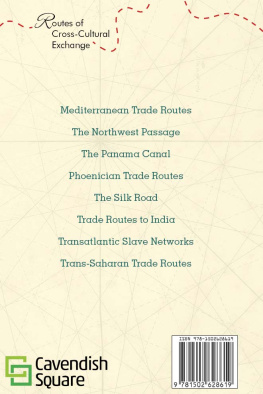Heing Bridget - Phoenician Trade Routes
Here you can read online Heing Bridget - Phoenician Trade Routes full text of the book (entire story) in english for free. Download pdf and epub, get meaning, cover and reviews about this ebook. publisher: Cavendish Square Publishing LLC, genre: History. Description of the work, (preface) as well as reviews are available. Best literature library LitArk.com created for fans of good reading and offers a wide selection of genres:
Romance novel
Science fiction
Adventure
Detective
Science
History
Home and family
Prose
Art
Politics
Computer
Non-fiction
Religion
Business
Children
Humor
Choose a favorite category and find really read worthwhile books. Enjoy immersion in the world of imagination, feel the emotions of the characters or learn something new for yourself, make an fascinating discovery.
- Book:Phoenician Trade Routes
- Author:
- Publisher:Cavendish Square Publishing LLC
- Genre:
- Rating:3 / 5
- Favourites:Add to favourites
- Your mark:
- 60
- 1
- 2
- 3
- 4
- 5
Phoenician Trade Routes: summary, description and annotation
We offer to read an annotation, description, summary or preface (depends on what the author of the book "Phoenician Trade Routes" wrote himself). If you haven't found the necessary information about the book — write in the comments, we will try to find it.
Phoenician Trade Routes — read online for free the complete book (whole text) full work
Below is the text of the book, divided by pages. System saving the place of the last page read, allows you to conveniently read the book "Phoenician Trade Routes" online for free, without having to search again every time where you left off. Put a bookmark, and you can go to the page where you finished reading at any time.
Font size:
Interval:
Bookmark:
R outes of Cross-Cultural Exchange
Phoenician Trade Routes
Bridey Heing

Published in 2018 by Cavendish Square Publishing, LLC
243 5th Avenue, Suite 136, New York, NY 10016
Copyright 2018 by Cavendish Square Publishing, LLC
First Edition
No part of this publication may be reproduced, stored in a retrieval system, or transmitted in any form or by any meanselectronic, mechanical, photocopying, recording, or otherwisewithout the prior permission of the copyright owner. Request for permission should be addressed to Permissions, Cavendish Square Publishing, 243 5th Avenue,
Suite 136, New York, NY 10016. Tel (877) 980-4450; fax (877) 980-4454.
Website: cavendishsq.com
This publication represents the opinions and views of the author based on his or her personal experience, knowledge, and research. The information in this book serves as a general guide only. The author and publisher have used their best efforts in preparing this book and disclaim liability rising directly or indirectly from the use and application of this book.
CPSIA Compliance Information: Batch #CS17CSQ
All websites were available and accurate when this book was sent to press.
Library of Congress Cataloging-in-Publication Data
Names: Heing, Bridey, author.
Title: Phoenician trade routes / Bridey Heing.
Description: New York : Cavendish Square Publishing, [2018] | Series: Routes of cross-cultural exchange | Includes bibliographical references and index.
Identifiers: LCCN 2016052780 (print) | LCCN 2016054836 (ebook) | ISBN 9781502628619 (library bound) | ISBN 9781502628626 (E-book)
Subjects: LCSH: PhoeniciansJuvenile literature. | Trade routesMediterranean RegionHistoryJuvenile literature. | Mediterranean RegionHistoryTo 476Juvenile literature.
Classification: LCC DS81 .H37 2017 (print) | LCC DS81 (ebook) | DDC 937/.01dc23
LC record available at https://lccn.loc.gov/2016052780
Editorial Director: David McNamara
Editor: Caitlyn Miller
Copy Editor: Michele Suchomel-Casey
Associate Art Director: Amy Greenan
Designer: Jessica Nevins
Production Coordinator: Karol Szymczuk
Photo Research: J8 Media
The photographs in this book are used by permission and through the courtesy of: Cover, De Agostini Picture Library/Getty Images; p..
Printed in the United States of America
I ntroduction
Powering the Ancient World Through Trade
T rade has been a key way for people to share culture, goods, and ideas throughout human history. In the ancient world, where communication and travel were limited, trade was even more important. It was through trade that civilizations were able to communicate and learn from and about each other. Traders pushed mankind forward as they exchanged products, currency, and skills. For centuries, the Phoenicians were leaders in cross-cultural trade. They connected the Mediterranean and western Asia through their commercial networks and shaped the civilizations of their time.
Phoenicia was a group of city-states along the eastern coast of the Mediterranean, focused around modern Lebanon and Syria. The cities of Phoenicia were independent but had a cultural identity that linked them together. Phoenicia is believed to have been established in 1500 BCE and lasted until 539 BCE, when Persian Cyrus the Great conquered it.

The Phoenicians were skilled at building ships, as shown by this carving found on the side of a sarcophagus in the ancient city of Sidon.
In the one thousand years Phoenicia was independent, it established trade routes that were extremely influential. The Phoenicians traded by sea and by land. Their routes stretched to Greece, Mesopotamia, and India. These routes were for both export and import, allowing merchants to serve as a connection between the Eastern and Western ancient worlds. The important role they played is clear in the art, writings, and accounts of the many empires and cultures with which they interacted. Phoenicia is mentioned in the works of Homer and the Bible and seen in art in Arabia.
Trade was the basis of Phoenicias economy, and it made the Phoenicians very wealthy. Some of Phoenicias earliest trade was with Greece, where Phoenicias Tyrian purple dye was used by elites in their clothing. Over the course of centuries, Phoenician merchants became the eras most successful traders. Dye would remain one of their most important exports, along with cedar wood and glass. Phoenicians also traded in silver and tin. They brought these two metals from Spain and other western ports to the East to be mixed with copper to make bronze. They also traded in wine, pottery, food, animals, and papyrus, among other goods.
But it wasnt just goods that Phoenicians brought through their trade routes. Phoenicia was the first civilization to develop a phonetic alphabet, which they used in their trade business and quickly spread to other parts of the world. The development of a phonetic alphabet was a major step in the evolution of writing, which had been based on hieroglyphic-like symbols rather than individual letters. The Greek alphabet is based on it, meaning that all European alphabets (which are based on the Greek alphabet) are part of the Phoenician trade legacy.
Trade routes served another purpose as well: helping Phoenicia establish colonies. While Greece dominated the northern Mediterranean, Phoenicia controlled the south and set up trade posts along its routes. These eventually grew into colonies, many of which still exist as modern cities, such as Tripoli in Libya, Palermo in Sicily, and Ibiza in Spain. One of the most influential was Carthage, in what is now Tunisia in North Africa. Carthage developed into an empire, fought wars with Greece and Syracuse, and eventually fell to the Roman Empire. It was rebuilt by Julius Caesar and became one of the Roman Empires largest cities and an influential center of Christianity.
Although little is known about Phoenician culture outside of trade, its legacy makes clear how important trade routes were to the ancient world. These pathways between cultures were the primary way that civilizations advanced, made peace, learned, and communicatedall at a time when travel was incredibly difficult and dangerous. The Phoenician trade routes were among the most advanced of their time, making the small Phoenician coastal civilization one of the guiding forces of the ancient world. For over one thousand years, Phoenicia was a link between East and West, connecting far-flung empires and cultures to create a business empire.
In this book, we will explore the way Phoenicians established their trade routes, how those routes were used to influence the ancient world, and what legacy Phoenicia left behind. We will discuss the goods, ideas, and people who made Phoenician trade routes some of the most important in their time, the challenges merchants faced, and what became of the trade routes as history went on.
Trade has always been about more than business it shapes our culture and history. For Phoenicia, that meant playing a role in some of the greatest empires mankind has ever known.

Before the Late Bronze Age Collapse, the Minoans were the dominant traders in the Mediterranean. This Minoan fresco was excavated on Knossos.
C hapter 1
Next pageFont size:
Interval:
Bookmark:
Similar books «Phoenician Trade Routes»
Look at similar books to Phoenician Trade Routes. We have selected literature similar in name and meaning in the hope of providing readers with more options to find new, interesting, not yet read works.
Discussion, reviews of the book Phoenician Trade Routes and just readers' own opinions. Leave your comments, write what you think about the work, its meaning or the main characters. Specify what exactly you liked and what you didn't like, and why you think so.












